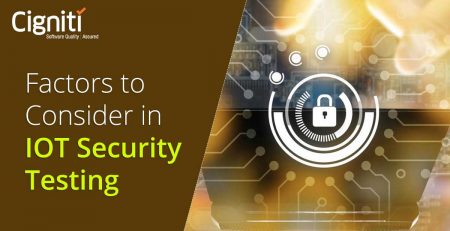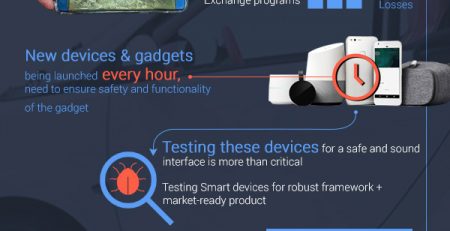The need for IoT testing in a hyperconnected world
There are a number of things that have changed – things that demarcate this world into pre-COVID and post-COVID. Technology is one of them. The outbreak has changed how people perceive technology and how much penetration of technology they want in their lives.
People who were scared of trying autonomous vehicles and driverless cars, those who were apprehensive of the delivery drones and remote monitoring tools, are now being more open to the idea of such technological advancements becoming a critical part of their day-to-day lives. In the time when social distancing is essential, these technologies have been and will continue to be inevitable for ensuring that lives, in general, run as usual.
From healthcare institutions to manufacturers and industrialists, everyone is looking up to digital technology solutions for finding an innovative way for surviving, and maybe thriving, in a pandemic-ridden world. Robots are making food deliveries, unmanned vehicles are transporting essential medical supplies, small-time retailers have gone digital, while schools and offices are operating remotely.
Steve Koening, VP of Market Research for the Consumer Technology Association, accurately said, “COVID-19 is stimulating innovation to adapt to a new normal…and shifting consumer behavior”
If we look at the bigger picture, comprised of all these smaller elements, the pandemic has resulted in a one, gigantic, highly-intertwined, always connected, continuous, and collaborative digital network of Internet of Things (IoT), which leads to Internet of Everything (IoE).
Internet of Things connects digital devices and Internet of Everything, as the name suggests, connects everything. It connects people, processes, and data to deliver a unified experience to the users, with the goal to have new capabilities, richer experiences, and unprecedented economic opportunity for business, individuals, and countries.
The global number of IoT-connected devices is projected to increase to 43 billion in the next three years. In the last few years, IoT has shifted from being a tech opportunity to a business opportunity. And now, it is offering us the opportunity to continue and keep moving forward in the time when everything is at a standstill. However, for ensuring that the IoT applications serve as intended, it is important to address five key factors – Connectivity, Continuity, Compliance, Co-existence, and Cybersecurity.
- Connectivity: To ensure connection of an IoT device with other IoT devices, the cloud, sensors, and anything that is required to be in the network for building a unified experience.
- Continuity: To ascertain the ability of the IoT devices to deliver continuously.
- Compliance: To make the IoT devices compliant to the global regulations
- Co-existence: For guaranteeing that the inter-connected IoT devices work seamlessly and harmoniously with one another.
- Cybersecurity: To safeguard the IoT devices and the data generated from malicious cyber risks and any security vulnerabilities.
Testing IoT applications is an ideal way of addressing all these five factors and making sure that the IoT devices perform to their optimum.
Why do you need to perform IoT testing?
Internet of Things or Internet of Everything is about real-time collaboration and interoperability. A performance glitch in one part can negatively impact the performance of the entire network. A cyberattack on one node can compromise the other as well.
“The IoT demands an extensive range of new technologies and skills that many organizations have yet to master,” said Nick Jones, vice president and distinguished analyst at Gartner. “A recurring theme in the IoT space is the immaturity of technologies and services and of the vendors providing them. Architecting for this immaturity and managing the risk it creates will be a key challenge for organizations exploiting the IoT. In many technology areas, lack of skills will also pose significant challenges.”
The need for IoT testing becomes clear when we consider the five factors of connectivity, continuity, compliance, co-existency, and cybersecurity. IoT testing services impart predictability to the services and help prevent unexpected outages. When testing is performed on the IoT devices, it becomes possible to identify any weak nodes in the network beforehand and apply the corrective measures proactively. Doing so ensures that the end users do not experience any glitch or interruption when they are interacting with the IoT applications.
Further, by performing IoT penetration testing and IoT security testing, the IoT devices can be scanned for any risks or vulnerabilities that may expose the sensitive user information to the hackers. IoT performance testing is essential to ensure that the IoT applications do not crash or break down under heavy concurrent usage and are capable of transmitting information as and when required. By assuring quality of the IoT network through software testing and quality engineering services, it becomes possible to effectively address the all five factors of IoT.
How can we help
With a 360-degrees application & software security testing services, you can detect vulnerabilities, stay compliant, and save costs. Cigniti’s experience in IoT app Testing as a Service (TaaS), a team of IoT-skilled testers, and a robust IoT testing infrastructure (labs, simulators, test racks, etc.,) support real-time testing of Big data, compatibility, IoT security, performance, pilot, regulatory, reliability, upgrade, usability, and smart devices in a dynamic environment (RFID, Sensors).
For many of our clients, we have successfully improved the overall test coverage by 90%, app quality by 30%, and time-to-market by 30% while reducing the overall costs by 40%, regression testing time by 83%, and defects by 80%.
Cigniti’s IoT-skilled testers are experienced in using multiple IoT network protocols such as Bluetooth, Zigbee, Z-Wave, 6LoWPAN, Thread, Wi-Fi, Cellular, NFC, SIGFOX, Neul, LoRaWAN, and more. Enterprises utilize our skills to overcome their IoT testing challenges and move ahead successfully in their digital transformation journey. Schedule a consultation with one of our IoT experts today.





Leave a Reply